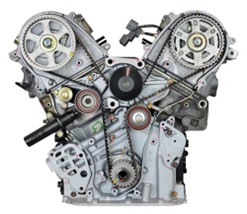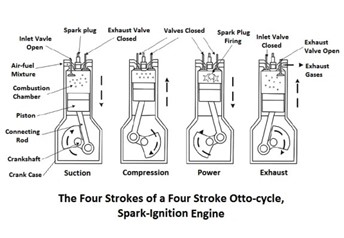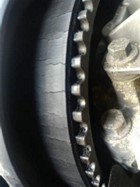 All four stroke Otto cycle engines use some kind of timing belt (Black toothed belt in the picture), chain, or gears to keep all of the moving parts inside the engine in alignment and moving in the correct order. Each cylinder in an engine has four distinct events that complete one power cycle; intake, compression, power, and exhaust strokes. The piston goes up and down two times per one power cycle. Valve openings and closings must be timed to the piston position and are controlled by camshaft rotation (Large gears on the top are attached to the camshafts). While the piston osolations are controlled by crankshaft rotation (Small gear on the bottom is on the front of the crankshaft). The crankshaft makes two complete revolutions for each single revolution of the camshaft. These components must work in concert with each other for the engine to run smoothly and efficiently. If this alignment gets out of sync it can cause numerous problems. Ranging from check engine light illumination to a non-running engine.
All four stroke Otto cycle engines use some kind of timing belt (Black toothed belt in the picture), chain, or gears to keep all of the moving parts inside the engine in alignment and moving in the correct order. Each cylinder in an engine has four distinct events that complete one power cycle; intake, compression, power, and exhaust strokes. The piston goes up and down two times per one power cycle. Valve openings and closings must be timed to the piston position and are controlled by camshaft rotation (Large gears on the top are attached to the camshafts). While the piston osolations are controlled by crankshaft rotation (Small gear on the bottom is on the front of the crankshaft). The crankshaft makes two complete revolutions for each single revolution of the camshaft. These components must work in concert with each other for the engine to run smoothly and efficiently. If this alignment gets out of sync it can cause numerous problems. Ranging from check engine light illumination to a non-running engine.

 Does my vehicle have a timing belt, timing chain, or timing gears? Modern engines usually use timing belt(s) or timing chain(s). The main difference between a timing belt and a timing chain is the area in the engine in which they operate. Timing belts run in a dry compartment while timing chains operate in a wet compartment lubricated by engine oil. While they function very similarly as they both control the timing and rotation of the camshaft(s). Maintenance intervals are drasticly different between the two systems. Timing belts are used because they provide a quiter operation and are less costly to manufacturer. They are typically used on base to mid level engine platforms. Timing belts consist of a rubber compound for the tooth surface and on the top with a corded layer in the center for strength.
Does my vehicle have a timing belt, timing chain, or timing gears? Modern engines usually use timing belt(s) or timing chain(s). The main difference between a timing belt and a timing chain is the area in the engine in which they operate. Timing belts run in a dry compartment while timing chains operate in a wet compartment lubricated by engine oil. While they function very similarly as they both control the timing and rotation of the camshaft(s). Maintenance intervals are drasticly different between the two systems. Timing belts are used because they provide a quiter operation and are less costly to manufacturer. They are typically used on base to mid level engine platforms. Timing belts consist of a rubber compound for the tooth surface and on the top with a corded layer in the center for strength.
Timing belts can stretch and crack and tend to break down over time. All vehicle manufacturers have recommended service intervals for the timing belts. Some as early as every 30,000 miles. Usually a replacement is recommend somewhere between 60,000 – 120,000 miles, depending on vehicle manufacturer. To prevent costly engine repair it is best to replace the timing belts at the manufacturer’s recommended intervals. It is also a good idea to replace any of the components, like the tensioner pulley, idler pulleys, or water pump, that are in contact with the timing belt at the same time. A failure of any one of these components can result in the same poor running or non-running engine.

What happens if the timing belt fails? A properly maintained timing belt sould never fail but, if it does the very first thing a driver will notice is the engine will run very poorly or not at all. In most cases the timing belt will fail when you are driving down the road. You may hear a clank or bang and the engine will stop. When you try to start it again it will spin over quickly and sound unusual. Sometimes internal mechanical damage can occur due to the percise alignment of the moving components(valves and pistons). These are called interference engines. When the pistons do not rotate in time with the valves they can contact the open valves. This bends the valves and can damage the cylinder heads and/or pistons. This kind of internal engine damage can be very costly to repair. Additional pulleys and a tensioner are used to keep the timing belt tight and routed correctly. Often the water pump is a part of this system. (Black pulley in the middle.) A failure of any one of these components can result in the same problems mentioned above. Maintenance is the key with these systems.
Is it expensive to replace the timing belt and components? It can be, but it is always less costly to maintain the system then waiting too long and having to pay for the additional internal engine repairs. Would you like to see if your vehicle has a timing belt and if it is due for maintenance? Just stop in and see the experts at Sanderson Auto Repair!